How running has changed since the 4-minute Mile

When I was a child in the late 1950s, my parents taught me about Bannister's Mile just as they taught me about the first climbing of Mount Everest.
By Mary Beard, BBC.com
As we approach the 60th anniversary of the 4-minute Mile, historian Mary Beard reflects on what has changed in the sport of running.
In a few days' time it will be the 60th anniversary of the first 4-minute Mile. On May 6, 1954, at Iffley Road sports ground in Oxford, Roger Bannister, supported by his friends Chris Brasher and Chris Chataway, ran a Mile race in 3 minutes 59.4 seconds. If we leave aside the story of James Parrott, who is supposed to have raced a Mile around the streets of Shoreditch in three minutes something on May 9, 1770, this was the first time a human being had cracked the 4-minute Mile barrier. Certainly, the first time it was fully ratified by an array of official stopwatches.
When I was a child in the late 1950s, my parents taught me about Bannister's Mile just as they taught me about the first climbing of Mount Everest. These were meant, I suppose, to be patriotic lessons in the physical prowess of Britain and the Commonwealth. I can still vividly conjure up in my mind the famous image of Bannister breaking through the finishing tape in triumph (though frankly I now think that he looks more in agony than in triumph).
Continue reading with audio at: www.bbc.com
